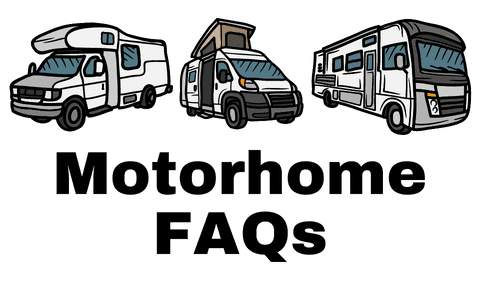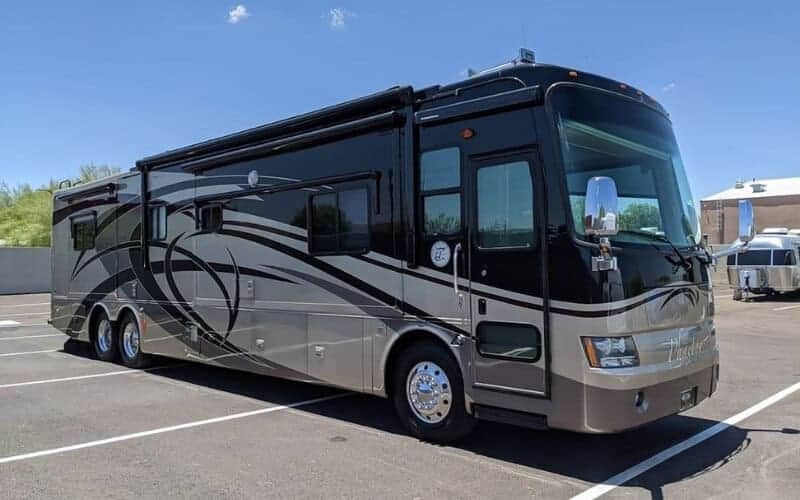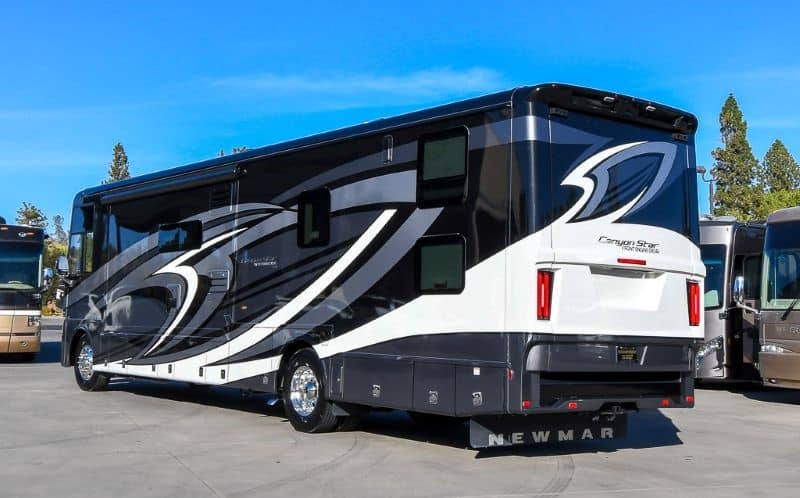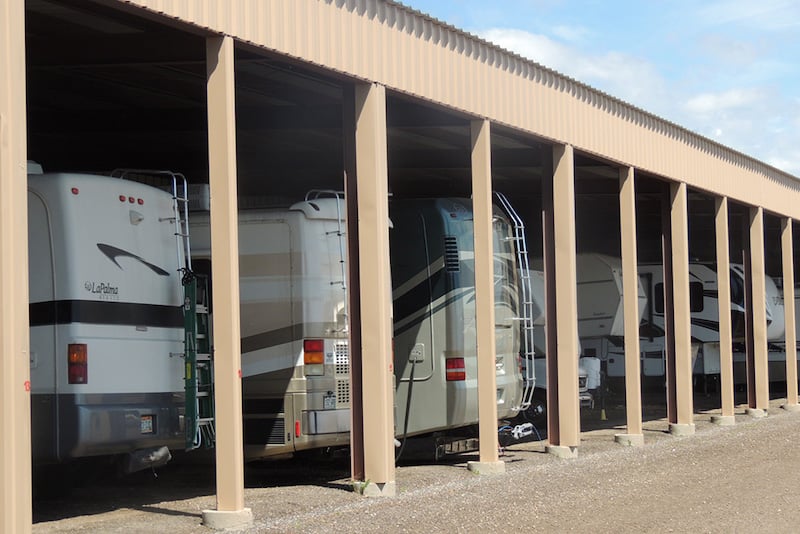An RV steering stabilizer is a term you’ll hear often in motorhome RVer circles. The idea of cruising down the interstate at 70 mph, when the steering suddenly starts wobbling back and forth, is a frightening one. Fortunately, the degradation in the front-end suspension and steering linkage is a gradual one.
For some, the factory suspension and steering linkage just isn’t up to snuff, even when it’s brand new. The good news is, there are quite a few RV steering stabilizer products (also known as a reflex steering stabilizer) on the vast RV components market.
It’s a good idea to get familiar with the different types. This article will walk you through the basics of these stabilizers, with a dash of history, the dangers of the “death wobble,” as it’s sometimes known, and some key information on installation. Fun stuff!
What is an RV Steering Stabilizer?
An RV steering stabilizer is a simplistic system that includes a spring or a hydraulic bar to keep your motorhome centered on the road, without any steering wobble. It doesn’t actually correct your steering wheel or anything; it stabilizes your steering experience as a whole, making sure there is resistance there to counter the looseness of power steering.
Depending on what type you go for, they can be a little on the expensive side to relatively inexpensive. It’s also one of those deals that might turn into a DIY project or might not. Again, what type you choose to go with helps determine that, along with your personal situation.
How Does an RV Steering Stabilizer Work?
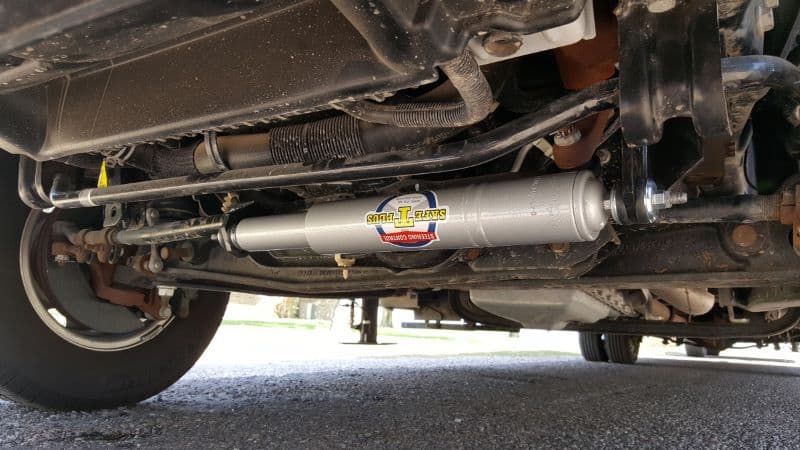
An RV steering stabilizer works by elevating the resistance in steering. It reduces the back-and-forth movement of your suspension, improving the overall handling. Since there are a number of different stabilizers, they each accomplish the same goal in their own way.
With a spring stabilizer, the spring itself acts as the resistance. The hydraulic bar variations use hydraulics, rather than springs, to stiffen the left and right movements. Keep in mind, the steering wobble isn’t the actual steering wheel.
Your steering wheel is just the component you grab onto to control the vehicle’s movements. The war over your handling occurs well beneath the steering wheel, column, and your feet. Most steering stabilizers help to minimize the effects of steering wobble in general, along with additional benefits.
They also give the driver more control when driving over uneven roads, hitting potholes or speed bumps, and dealing with rough crosswinds on the highway. It simply makes for a much easier, more convenient, and more comfortable driving experience on the road.
Will An RV Steering Stabilizer Fix Wobble?
A stabilizer will fix wobble for the most part. There will always be a little give and take in your steering but even a class A motorhome will feel more like a standard driving experience most people expect when climbing behind the wheel.
It’s important to remember that steering stabilizers are sometimes thought of as temporary solutions. That’s because they could mask significant issues. If you’re experiencing steering wobble, getting your motorhome checked out is important.
Blown-out tires are obvious, but loose ball joints, out-of-round brake rotors, a worn-out suspension system, or out-of-balance tires won’t fix themselves just because you install a steering stabilizer. These are issues that will continue to get worse, even as the steering stabilizer covers them up.
If you take your RV to the mechanic when you’re experiencing wobble, it may save you a lot of trouble down the road. It’s one thing if the factory trackbar is just defective. It’s quite another if an important component is gasping its last breath and the steering stabilizer simply gives it a few more.
Can You Install An RV Steering Stabilizer On All Motorhome Classes?
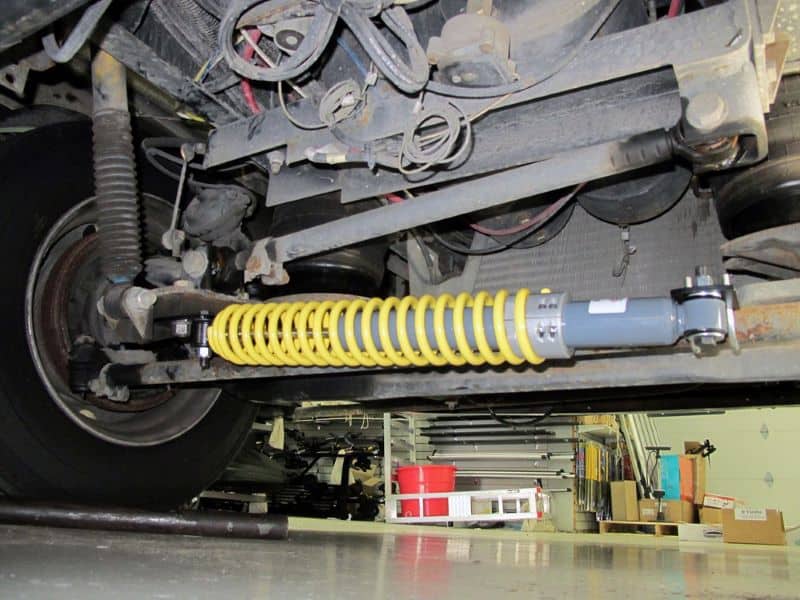
Yes, you can install an RV steering stabilizer on Class B, Class C, and Class A motorhomes. Many of them you can do yourself. Depending on your tools, the type of steering stabilizer, and your own capabilities, you can turn it into a DIY project if you wish.
Most Class A motorhome owners will probably recommend a steering stabilizer as a complimentary component to the existing, factory solution. Even a massive Class A motorhome doesn’t require anything extensive and steering stabilizers are anything but.
These are relatively simple devices and the most you will have to do is get on your back, unbolt the original trackbar, install the steering stabilizer (with more bolts), and return the trackbar to its original position.
Steering stabilizers aren’t massive and they aren’t heavy. They’re simply accommodating hardware that is relatively easy to install.
- To begin installing an RV steering stabilizer, jack up the front of the motorhome
- Grab your mounting brackets (they either come with or you have to purchase them separately)
- Mount the first mounting bracket to the chassis according to the instructions
- Place the second mounting bracket on the passenger side frame
- Connect the steering stabilizer between the two mounting brackets
- Test drive the motorhome
Now, obviously, that is a very truncated instruction manual. However, most RV steering stabilizers should take no more than an hour to install yourself. In some cases, you will have to remove the existing track bar to mount the stabilizer, returning the trackbar once the former is properly installed.
Every motorhome is a little bit different but it’s mostly a bolt loosening, removing and tightening operation. If you feel like it’s too much, don’t go ahead with it. Instead, take your motorhome to a qualified technician who can palace the steering stabilizer for you.
The Best RV Steering Stabilizers
As mentioned above, there are a lot of steering stabilizers on the market. This isn’t a brand-new technology after all. However, as with everything, a few brands separate themselves from the crowded marketplace.
1. Roadmaster
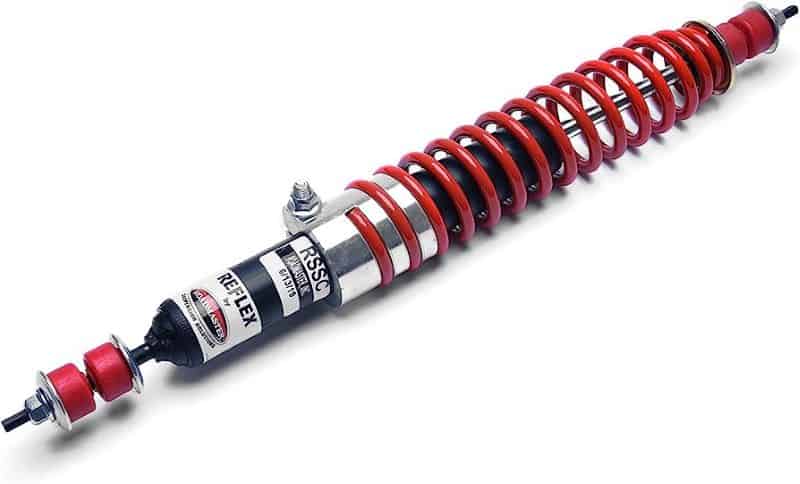
The Roadmaster is one of the most popular steering stabilizer options on the RV market, mostly because it’s highly effective, easy to install, and very affordable. The Roadmaster is made with a tempered steel spring coil over a piston.
This allows the rod to piston in and out, with the tempered steel spring taking the load. The entire purpose behind the design is to create resistance whether you’re turning right or left. The spring is either pulling or pushing, depending on the direction of your turn.
It’s very easy to install, which is another major selling point. Most RVers can get beneath the motorhome and have it on in less than a few hours. The bad news is, the Roadmaster doesn’t come with the mounting brackets. You will have to purchase those separately.
Roadmaster devices come with a limited lifetime warranty, meaning it applies to the original owner, is not transferable, and the Roadmaster has to be purchased from an authorized retailer. If something goes wrong with the product, you have a 30-day period to call it in and file a claim.
Pros
- Easy to install
- Material is high quality
- Reduces sway from strong crosswinds
- Roadmaster offers factory installation
- Affordable
- Improves overall handling
Cons
- Doesn’t include mounting brackets
- Doesn’t fit every model under the sun (check beforehand)
- The instruction manual could do with more precise instructions
- Its open design allows debris and dust in between the springs and rod
2. Safe-T RV Steering Stabilizer
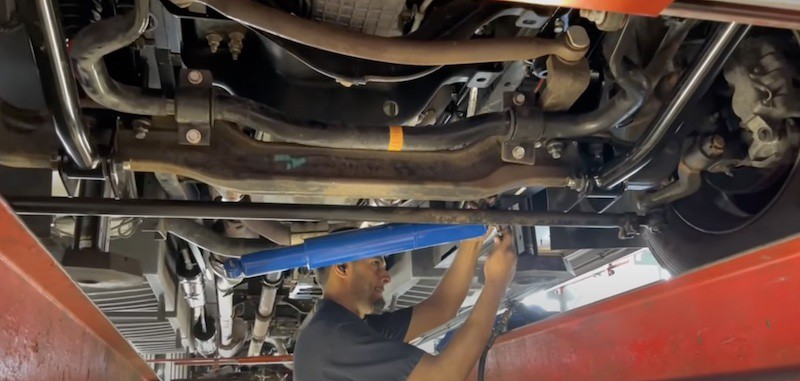
The biggest thing separating the Safe-T and the Roadmaster is price. The Safe-T RV Steering Stabilizer is definitely the more expensive option. Safe-T Stabilizers also lack the broad use of the Roadmaster because they require precision manufacturing for a number of specific RV types.
Unlike the Roadmaster, the Safe-T is a closed-system, hydraulic piston. It’s designed to bolt right into place, with very little in the way of extra tools or adjustments. Also, while the Roadmaster is designed to improve handling and deal with rough roads, the Safe-T is more for heavy crosswinds and dealing with blowouts.
The Safe-T also keeps your motorhome from wandering off the road and makes it easier to deal with semis or other Class A motorhomes blowing by you on the road. Depending on where you find the Safe-T, the vendor may sell it for upwards of $500 and as low as $300.
The Safe-T’s warranty is exceptional. The company offers a lifetime warranty against defects and faulty craftsmanship—that covers Safe-T RV Steering Stabilizers for Class A, B, and C motorhomes, as well as toy haulers and select travel trailers.
Pros
- Very easy to install
- Technical (Manual that comes with it) help is excellent
- Keeps the RV straight in heavy crosswinds
- Provides stability in the event of a tire blowout
- Factory installation is an option
- Lifetime warranty
Cons
- Doesn’t improve the overall handling of the RV
- May not fit every RV
FAQs On RV Steering Stabilizers

1. How do I know if I need an RV steering stabilizer?
If your steering is wobbly when you’re doing nothing more than driving down the road. If you have to fight against crosswinds or have trouble staying centered on rough roads. In other words, if you’re physically exhausted at the end of the trip.
2. Can I install an RV steering stabilizer DIY?
For the most part, absolutely. As long as you are more than capable and have the tools handy, you should be able to turn it into a fairly quick, DIY project. There may be an exception or two out there, depending on the type of stabilizer.
3. Will I Ever Need to Replace My RV Steering Stabilizer?
It depends on the stabilizer and what you are using it for. We mentioned it being a sort of band-aid earlier, masking the damage from components that need to be replaced. In these cases, they are temporary or useful later down the road.
4. Do modern motorhomes have steering stabilizers?
Most modern motorhomes have some sort of steering stabilization system, with some standing out—in terms of performance and efficiency—over others. However, that doesn’t mean you can use a steering stabilizer as a replacement if it works better. It’s a matter of doing your homework and going with what works best for you.
Final Thoughts On RV Steering Stabilizers
Steering stabilizers are saturating the market, quickly becoming a dime a dozen. However, there are a number of highly efficient stabilizers out there, including the two we listed above. Most of these devices are fairly simplistic and easy to install. Better yet, most are affordable.
If you’re consistently dealing with sway on the highway or tired of fighting the wheel to maintain center over long trips, an RV steering stabilizer is an ideal solution. Most of them are more than effective at eliminating disruptions from passing semis, providing you with more control in the wind, and stabilizing the RV on rough roads.
Some go so far as to improve the overall handling, making for a much easier, long-distance trip. If you only haul the motorhome out once or twice a year, it may not be worth the investment. But if you’re a lifer or travel a lot, you should strongly consider adding a stabilizer to your RV.
Related Reading
1. RV Oil Change: Average Cost for Engine Service
2. Can You Patch or Plug RV Tires?
3. 9 Best Air Compressors for RV Tires
4. How Much Can a Class A Motorhome Tow?
About the Author:
Thomas Godwin is a full-time freelance writer with a BFA in Creative Writing, a U.S. Marine, and an avid outdoorsman.
When he’s not writing, he’s raising chickens and Appleyard ducks. Thomas also constructs teardrop campers (attempting to anyway) and kayaks the Blackwater River with his wife, two daughters, and his Dobermans.

